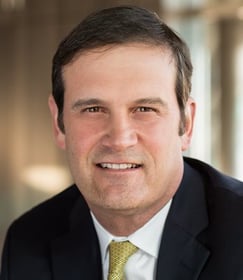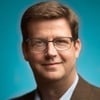What was going on with you career-wise prior to this position?
I had a long career at Monsanto, during which I had opportunities to work mostly in IT, but also in the commercial organization and supply chain. Additionally, I had the opportunity to work in many places around the world like Brazil, Mexico, Argentina, St. Louis, and California, among others. My career kept getting more interesting, especially as Monsanto started to become more digitally oriented.
Were you actively looking for a new CIO role?
After Bayer’s integration with Monsanto, I started to think about the next steps in my career plan. Maybe this was the moment to make a change, and perhaps there was chance to lead a whole IT organization. I’d been a divisional CIO, but never an enterprise or corporate CIO.
Then a recruiter called me about a $10 billion organization looking for an enterprise CIO. He didn’t say what company at first, but it sounded very interesting and eventually it turned out to be Eastman. I went through four interview rounds which led to receiving a job offer.
What piqued your interest in the CIO role at Eastman?
 Eastman had spun off from Kodak years ago to focus on specialty materials and chemicals. Specialty materials and chemicals is a segment where the way you apply products in the market and the way you provide differential value to customers is critical.
Eastman had spun off from Kodak years ago to focus on specialty materials and chemicals. Specialty materials and chemicals is a segment where the way you apply products in the market and the way you provide differential value to customers is critical.
The concept of creating differential value for customers, for me, connected directly to services, and services connected directly to digital. I saw many opportunities, starting with modernizing the company internally and finding opportunities to help create value to our customers externally.
What was Eastman looking for in their new CIO?
They knew that, as a company, they were playing in a progressive space, and that digital business is on the agenda of the industry. They were aware of some major opportunities and felt they needed someone who could guide the company through all of it, and become a digital champion.
|
About Eastman Eastman (NYSE: EMN, $10B) is a global specialty materials company that produces a broad range of products found in items people use every day. Eastman's end markets include transportation, building and construction, and consumables. Headquartered in Kingsport, TN, Eastman employs approximately 14,500 people around the world and serves customers in more than 100 countries. |
How much did you prepare in advance for your interviews?
I prepared a lot. I feel preparation is extremely important. I focused a lot on being ready to relate events and achievements in ways that were simple and clear: things that could be remembered, things that had impact. In interviews, just like when delivering a speech, I am convinced that simplicity, and the audience’s ability to remember your ideas, makes a big difference.
How did you prepare to start your new role?
Since I hadn’t changed companies for a while, I reread The First 90 Days, by Michael Watkins, talked to a lot of people, asked for advice, and prepared a plan based on five dimensions.
Can you summarize the five dimensions your 90-day plan?
- Learning: What were the activities I needed to prioritize, and what did I need to learn most about the company and our businesses? Also, who would I meet to start building my network?
- Digital Journey Plan: With the team we developed a plan showing what Eastman’s upcoming digital journey would look like, establishing a north star for the organization. To do this, we spent time scanning the company, first to understand the strengths and opportunities within IT at Eastman. Second, what were the opportunities we had both from a monetary value as well as a strategic perspective for our business and customers? Each of these were mapped, with focused prioritization in six areas. In month four, I presented this plan to leadership of the company and the board of directors.
- People: I spent time to understand how the organization really operated. I talked to people, listened to feedback and sought external advice, all which helped us identify key areas we needed to address from a people perspective.
- Culture: What are the elements of Eastman that, from a digital perspective, we would need to supplement to get people to be more comfortable and embrace the plan? This was about behaviors and communication. My corporate communications partner built a communications plan about how we are thinking about digital across the company under the umbrella of “Eastman Digital”
- My personal life: It was important to give this aspect of the transition sufficient time and attention. My family was moving and changing cities again, selling our house, and buying a new house. It is important to properly acclimate the family to the new city and situation.
What are the six areas of the digital journey that you presented to the executives and the board?
- Data and decision making
- Business enablement; which is about efficiency and effectiveness
- Streamlining the operations; with focus on our manufacturing and planning landscape
- Commercial excellence; connecting with our customers
- Technology innovation; digitizing our research and development pipeline
- Digital products for the market.
Have there been any early wins from this plan that you can share?
Yes, there is an example under data and decision making. We knew information technology could play a role in simplifying the way data flows and gets integrated, the way decisions get made, and how best to apply analytics as needed. We launched something we now call “Certified Dashboards”, which are common sets of information that are accessible in real-time, and made available at the same time to the entire company, from the CEO down to the very last person in the organization.
This was not only a technical deployment but also a cultural shift. The idea of data democratization emphasizes that the data is available and to be used by everyone to help make better, faster decisions. We also activated an agile approach for this through iterations. We launched products in the first few months that were beta versions.
High quality is important in a chemical company, so the concept of beta versions and iteration was also a cultural shift. As these simple solutions evolve, we are incorporating predictive analytics through our Data Science practice using this single source of truth.
Heller Search is in the IT talent business, so I have to ask, what was in the People component of your plan?
We completed an assessment of the organization and detected three areas of opportunity. The organization was solid technically, but needed stronger integration with the rest of the business. That is the first area of opportunity. So, we are creating the necessary organizational structure to better connect with the business units and different functions across the company. To accelerate that, I am bringing into the IT organization people with no IT background.
The second focus area has been around the domains where we felt we didn’t have enough experience. We have since formed new teams around information management, enterprise architecture, and digital products.
And third is about diversity and inclusion. We have become very targeted with the way we are designing the organization for the future, and maximizing opportunities for leaders of all backgrounds, from all functions, across our global footprint.
What does digital transformation mean at Eastman?
The term 'digital' is broadly used. For Eastman, it is about modernizing the company, transforming complexity into competitive advantage, integrating the industry, and complementing our physical products with services. That’s what digital means for Eastman.
What exactly do you mean by “integrating the industry”?
It’s about customers as well as suppliers. Right now, our priority is understanding and connecting with customers, supporting them better. But gradually, the industry as a whole, is going to be much more integrated. Customers of one company are also suppliers of the same company. This pattern is pushing to create an ecosystem.
If you were granted a ‘redo’ on your first 90 days, what would you do differently?
I was pleasantly surprised by everything we accomplished in the first 90 days. On the soft side – people, communications, and culture – we probably could have gone a little faster, but we wanted to be conscious of the culture and the environment.
What advice do you have for an IT executive moving into his or her first CIO role?
I would share with them a philosophy I believe in, which is what I call “The double H” – always be humble but hungry. Go after opportunities with all the power that you have, but you must be extremely respectful and extremely humble with the people.
In this tight market, how do you attract and retain quality talent?
You have to have a very strong “Why”, something that gets people excited about the vision of the company. When people are excited about their work, they can better cope with whatever circumstance may be prompting them to consider coming or leaving.
The newest generation of hires is motivated by purpose and mission. We at Eastman view ourselves as being the innovators that are going to help change the world. We are putting ourselves out there on the cutting edge to do big things that will solve some of the world’s most perplexing problems, and investing heavily to do so. So, we like to reinforce that powerful “Why”. The work people are going to do if they join Eastman is going to make a material difference in the world, and make an impact on people’s lives.
There’s a lot going on. The plans, the people - I’m having the time of my life! I love this moment. It is an opportunity to move an amazing company to a new level, and to be a part of that journey.
About Aldo Noseda
Aldo Noseda joined Eastman as Vice President & Chief Information Officer in August 2018. Previously, Noseda held a variety of global information technology and management roles with Andersen Consulting and Monsanto. He is a graduate of National Technology University in Buenos Aires, with a degree in Information Systems and a graduate degree in Systems Engineering, as well as IAE University’s Executive Program in Business Administration.


Written by Steve Rovniak
Steve Rovniak served as Executive Director, Marketing and Media at Heller Search Associates from 2012 to 2023.



